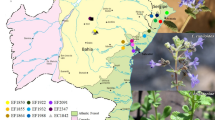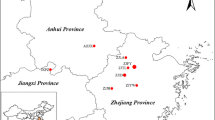Abstract
Dendrobium is an epiphytic orchid, which is highly valued as a cut flowers. The assessment of genetic diversity is crucial to study the relationship between the species and also to develop the novel hybrids. In this study, 25 cross species simple sequence repeat (SSR) markers were screened for amplification in Dendrobium species. Eighteen polymorphic markers were used to estimate the genetic diversity in 15 Dendrobium species. The 18 SSR markers generated a total of 55 polymorphic bands, with an average of 3.05 bands per primer. The observed and expected heterozygosity within the species ranged from 0 to 0.62 and 0.30 to 0.86, respectively. Cluster analysis based on the unweighted pair group method with an average led to a dendrogram with three major groups that coincided for morphological characters mostly for flower colour, flower shape and nature of shoot, but did not coincide with their geographical locations. Results revealed that genetic variation exists amongst the 15 Dendrobium species, which will be helpful in selecting desirable species as a parent for crossing purpose to develop new interspecific hybrids.




Similar content being viewed by others
Data availability
Raw data are available upon request from the corresponding author.
References
Banks SC, Peakall ROD (2012) Genetic spatial autocorrelation can readily detect sex biased dispersal. Mol Ecol 21:2092–2105
Basavaraj B, Nagesha N, Jadeyegowda M (2020) Molecular characterization of Dendrobium orchid species from western ghat region of Karnataka using RAPD and SSR markers. Int J Curr Microbiol App Sci 9:2157–2169
Bhargav V, Kumar R, Sane A, Rao TM, Bharathi TU, Shankara KS, Reddy DL (2021) Molecular characterization of China aster (Callistephus chinensis (L.) Nees) genotypes using SSR markers. Isr J Plant Sci 68:287–296
Cai X, Feng Z, Hou B, Xing W, Ding X (2012) Development of microsatellite markers for genetic diversity analysis of Dendrobium loddigesii Rolfe, an endangered orchid in China. Biochem Syst Ecol 43:42–47
Doyle JJ, Doyle JL (1987) A rapid DNA isolation procedure for small quantities of fresh leaf tissue. Phytochem Bull 19:11–15
Fattmah SD (2011) Development of sequence-based microsatellite marker for Phalaenopsis orchid. Hayati J Biosci 18:71–76
Ge H, Liu Y, Jiang M, Zhang J, Han H, Chen H (2013) Analysis of genetic diversity and structure of eggplant populations (Solanum melongena L.) in China using simple sequence repeat markers. Sci Hortic 162:71–75
Huang Y, Li F, Chen K (2010) Analysis of diversity and relationships among Chinese orchid cultivars using EST-SSR markers. Biochem Syst Ecol 38:93–102
Jantasuriyarat C, Ritchuay S, Pattarawat P, Huehne PS, Kate-Ngam S (2012) Development and transferability of EST-SSR and transferability of genomic SSR markers for genetic diversity assessment of Doritis. Biochem Syst Ecol 45:57–65
Joshi KD, Subedi M, Rana RB, Kadayat KB, Sthapit BR (1997) Enhancing on-farm varietal diversity through participatory varietal selection: a case study for chaite rice in Nepal. Exp Agric 33:335–344
Kalia RK, Rai MK, Kalia S, Singh R, Dhawan AK (2011) Microsatellite markers: an overview of the recent progress in plants. Euphytica 177:309–334
Kang J, Lu J, Qiu S, Chen Z, Liu J, Wang H (2015) Dendrobium SSR markers play a good role in genetic diversity and phylogenetic analysis of Orchidaceae species. Sci Hortic 183:160–166
Lee HJ, Park HR, Lee AJ, Nam DE, Lee DG, Do Y, Chung KW (2020) Genetic authentication of cultivars with flower-variant types using SSR markers in spring orchid, Cymbidium goeringii. Hortic Environ Biotechnol 61:577–590
Li X, Jin F, Jin L, Jackson A, Huang C, Li K, Shu X (2014) Development of Cymbidium ensifolium genic-SSR markers and their utility in genetic diversity and population structure analysis in cymbidiums. BMC Genet 15(1):1–14
Li X, Qiao L, Chen B, Zheng Y, Zhi C, Zhang S, Cheng Z (2022) SSR markers development and their application in genetic diversity evaluation of garlic (Allium sativum) germplasm. Plant Divers 44:481–491
Liu X, Huang Y, Li F, Xu C, Chen K (2014) Genetic diversity of 129 spring orchid (Cymbidium goeringii) cultivars and its relationship to horticultural types as assessed by EST-SSR markers. Sci Hortic 174:178–184
Louarn S, Torp AM, Holme IB, Andersen SB, Jensen BD (2007) Database derived microsatellite markers (SSRs) for cultivar differentiation in Brassica oleracea. Genet Resour Crop Evol 54:1717–1725
Lu JJ, Suo NN, Hu X, Wang S, Liu JJ, Wang HZ (2012) Development and characterization of 110 novel EST-SSR markers for Dendrobium officinale (Orchidaceae). Am J Bot 99:e415–e420
Lu JJ, Gao L, Kang JY, Feng SG, He RF, Wang HZ (2013a) Thirteen novel polymorphic microsatellite markers for endangered Chinese endemic herb Dendrobium officinale. Conserv Genet Resour 5:359–361
Lu JJ, Kang JY, Feng SG, Zhao HY, Liu JJ, Wang HZ (2013b) Transferability of SSR markers derived from Dendrobium nobile expressed sequence tags (ESTs) and their utilization in Dendrobium phylogeny analysis. Sci Hortic 158:8–15
Moe KT, Zhao W, Song HS, Kim YH, Chung JW, Cho YI, Park YJ (2010) Development of SSR markers to study diversity in the genus Cymbidium. Biochem Syst Ecol 38:585–594
Ninawe AS, Swapna TS (2017) Orchid diversity of northeast India-Traditional Knowledge and strategic plan for conservation. J Orchid Soc India 31:41–56
Peakall ROD, Smouse PE (2006) GENALEX 6: genetic analysis in Excel. Population genetic software for teaching and research. Mol Ecol Notes 6:288–295
Ren R, Nagel BA, Kumpatla SP, Zheng P, Cutter G, Greene TW, Thompson SA (2012) Maize cytoplasmic male sterility (cms) c-type restorer rf4 gene, molecular markers and their use. U.S. Patent Application No.13/244,049
Rohlf FJ (1987) NTSYS-pc: Microcomputer programs for numerical taxonomy and multivariate analysis. Am Stat 41:330–330
Roy SC, Moitra K, De Sarker D (2017) Assessment of genetic diversity among four orchids based on ddRAD sequencing data for conservation purposes. Physiol Mol Biol Plants 23:169–183
Tamura K, Stecher G, Kumar S (2021) MEGA11: molecular evolutionary genetics analysis version 11. Mol Biol Evol 38:3022–3027
Varma AR, Rajshekhar I (2022) A review article on: an overview of medicinal importance of orchids. Acta Sci Med Sci 6:1–9
Wang HZ, Feng SG, Lu JJ, Shi NN, Liu JJ (2009) Phylogenetic study and molecular identification of 31 Dendrobium species using inter-simple sequence repeat (ISSR) markers. Sci Hortic 122:440–447
Wu F, Zhang S, Gao Q, Liu F, Wang J, Wang X (2021) Genetic diversity and population structure analysis in a large collection of Vicia amoena in China with newly developed SSR markers. BMC Plant Biol 21:1–12
Acknowledgements
The authors are thankful for the College of Horticulture and Forestry, Central Agricultural University, Pasighat, Arunachal Pradesh for extending the research facilities and Dr. Mahesh Kumar, College of Agriculture Pasighat for helping in editing the research article.
Funding
The research work was supported by College of Horticulture and Forestry, Central Agricultural University, Pasighat, Arunachal Pradesh.
Author information
Authors and Affiliations
Corresponding author
Ethics declarations
Conflict of interest
All the authors declare that there are no conflicts of interest to disclose.
Consent to participate
All author’s have given consent to participate.
Consent for publication
All authors have given consent to publication.
Additional information
Publisher's Note
Springer Nature remains neutral with regard to jurisdictional claims in published maps and institutional affiliations.
Rights and permissions
Springer Nature or its licensor (e.g. a society or other partner) holds exclusive rights to this article under a publishing agreement with the author(s) or other rightsholder(s); author self-archiving of the accepted manuscript version of this article is solely governed by the terms of such publishing agreement and applicable law.
About this article
Cite this article
Reddy, D.M., Momin, K.C., Singh, A.K. et al. Genetic diversity of Dendrobium species revealed by simple sequence repeat (SSR) markers. Genet Resour Crop Evol 71, 1453–1464 (2024). https://doi.org/10.1007/s10722-023-01701-w
Received:
Accepted:
Published:
Issue Date:
DOI: https://doi.org/10.1007/s10722-023-01701-w




